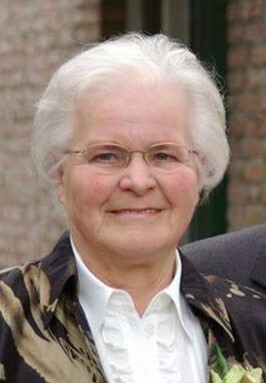Van Hoof Tree » Josina (Sien) (Francina?) van den Bogaard (1900-)
Personal data Josina (Sien) (Francina?) van den Bogaard
Source 1- She was born on July 14, 1900 in Lieshout.
- A child of Wilhelmus (Willem) van den Boogaard (Bogaard) and Gertruda (Geertruida) van Stiphout
Household of Josina (Sien) (Francina?) van den Bogaard
She is married to Antonius Arnoldus Vos.
They got married on August 31, 1922 at Lieshout, she was 22 years old.
Child(ren):
- (Not public)
- (Not public)
- (Not public)
- ?? 1929-1929
- Hendrika Maria Vos 1929-1929
- (Not public)
- ?? 1932-1932
- Hendrika Joanna Vos 1932-1932
- (Not public)
- (Not public)
- (Not public)
- (Not public)
- (Not public)
- ?? 1942-1942
- Henricus Wilhelmus Gerardus Vos 1942-1942
- ?? 1943-1943
- Levenloos Vos 1943-1943
Timeline Josina (Sien) (Francina?) van den Bogaard
This functionality is only available in Javascript supporting browsers.
Click on the names for more info.
Symbols used:  grandparents
grandparents
 parents
parents
 brothers/sisters
brothers/sisters
 children
children
 grandparents
grandparents
 parents
parents
 brothers/sisters
brothers/sisters
 children
children
Ancestors (and descendant) of Josina (Sien) (Francina?) van den Bogaard
Josina (Sien) (Francina?) van den Bogaard | |||||||||||||||||||||||||||||||||||||||||||||||||||||||||||||||||||||||||||||||||||||||||||||||||||||||||||||||
1922 | |||||||||||||||||||||||||||||||||||||||||||||||||||||||||||||||||||||||||||||||||||||||||||||||||||||||||||||||
Antonius Arnoldus Vos | |||||||||||||||||||||||||||||||||||||||||||||||||||||||||||||||||||||||||||||||||||||||||||||||||||||||||||||||
Sources
- VANHOOF TREE Web Site, John Van Hoof, via https://www.myheritage.com/person-150008...
Added by confirming a Smart Match
Stambomen op MyHeritage Familiesite: VANHOOF TREE Web Site Familiestamboom: 223135681-2
Historical events
Birthday July 14, 1900
- The temperature on July 14, 1900 was about 20.3 °C. The airpressure was 76 cm mercury. The atmospheric humidity was 54%. Source: KNMI
- Koningin Wilhelmina (Huis van Oranje-Nassau) was from 1890 till 1948 sovereign of the Netherlands (also known as Koninkrijk der Nederlanden)
- In The Netherlands , there was from July 27, 1897 to August 1, 1901 the cabinet Pierson, with Mr. N.G. Pierson (unie-liberaal) as prime minister.
- In the year 1900: Source: Wikipedia
- The Netherlands had about 5.1 million citizens.
- May 17 » Second Boer War: British troops relieve Mafeking.
- May 26 » Thousand Days' War: The Colombian Conservative Party turns the tide of war in their favor with victory against the Colombian Liberal Party in the Battle of Palonegro.
- May 29 » N'Djamena is founded as Fort-Lamy by the French commander Émile Gentil.
- August 14 » The Eight-Nation Alliance occupies Beijing, China, in a campaign to end the bloody Boxer Rebellion in China.
- October 19 » Max Planck discovers Planck's law of black-body radiation.
- December 18 » The Upper Ferntree Gully to Gembrook, Victoria Narrow-gauge (2ft 6 in or 762mm) Railway (now the Puffing Billy Railway) in Victoria, Australia is opened for traffic.
Day of marriage August 31, 1922
- The temperature on August 31, 1922 was between 10.2 °C and 19.1 °C and averaged 15.3 °C. There was 0.9 mm of rain. There was 4.9 hours of sunshine (36%). The average windspeed was 3 Bft (moderate breeze) and was prevailing from the south. Source: KNMI
- Koningin Wilhelmina (Huis van Oranje-Nassau) was from 1890 till 1948 sovereign of the Netherlands (also known as Koninkrijk der Nederlanden)
- In The Netherlands , there was from September 9, 1918 to September 18, 1922 the cabinet Ruys de Beerenbrouck I, with Jonkheer mr. Ch.J.M. Ruys de Beerenbrouck (RKSP) as prime minister.
- In The Netherlands , there was from September 19, 1922 to August 4, 1925 the cabinet Ruys de Beerenbrouck II, with Jonkheer mr. Ch.J.M. Ruys de Beerenbrouck (RKSP) as prime minister.
- In the year 1922: Source: Wikipedia
- The Netherlands had about 7.0 million citizens.
- April 3 » Joseph Stalin becomes the first General Secretary of the Communist Party of the Soviet Union.
- July 1 » The Great Railroad Strike of 1922 begins in the United States.
- July 11 » The Hollywood Bowl opens.
- August 27 » Greco-Turkish War: The Turkish army takes the Aegean city of Afyonkarahisar from the Kingdom of Greece.
- October 29 » King Victor Emmanuel III of Italy appoints Benito Mussolini as Prime Minister.
- December 9 » Gabriel Narutowicz is elected the first president of Poland.
Same birth/death day
- 1894 » Dave Fleischer, American animator, director, and producer († 1979)
- 1896 » Buenaventura Durruti, Spanish soldier and anarchist († 1936)
- 1898 » Happy Chandler, American lawyer and politician, 49th Governor of Kentucky, second Commissioner of Baseball († 1991)
- 1901 » George Tobias, American actor († 1980)
- 1901 » Gerald Finzi, English composer and academic († 1956)
- 1903 » Irving Stone, American author and educator († 1989)
About the surname Van den Bogaard
- View the information that Genealogie Online has about the surname Van den Bogaard.
- Check the information Open Archives has about Van den Bogaard.
- Check the Wie (onder)zoekt wie? register to see who is (re)searching Van den Bogaard.
The Van Hoof Tree publication was prepared by John Van Hoof.
When copying data from this family tree, please include a reference to the origin:
John Van Hoof, "Van Hoof Tree", database, Genealogy Online (https://www.genealogieonline.nl/van-hoof-tree/I503529.php : accessed May 6, 2025), "Josina (Sien) (Francina?) van den Bogaard (1900-)".
John Van Hoof, "Van Hoof Tree", database, Genealogy Online (https://www.genealogieonline.nl/van-hoof-tree/I503529.php : accessed May 6, 2025), "Josina (Sien) (Francina?) van den Bogaard (1900-)".
